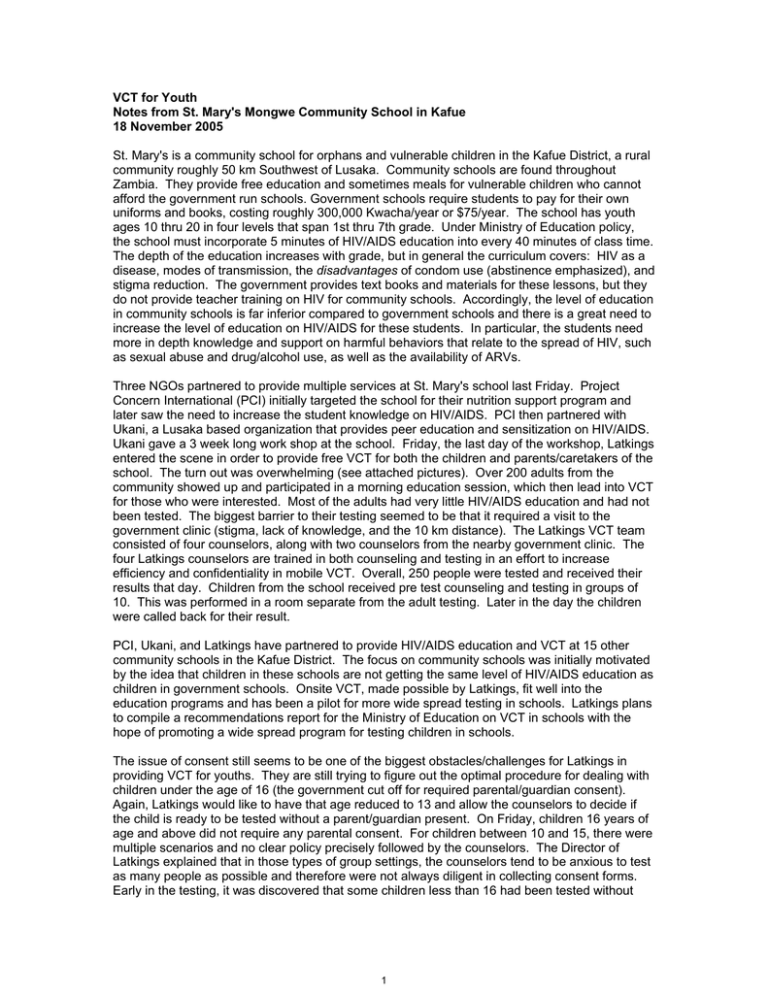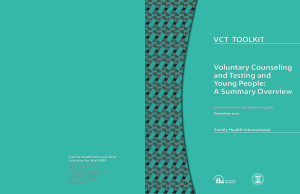
VCT for Youth
Notes from St. Mary's Mongwe Community School in Kafue
18 November 2005
St. Mary's is a community school for orphans and vulnerable children in the Kafue District, a rural
community roughly 50 km Southwest of Lusaka. Community schools are found throughout
Zambia. They provide free education and sometimes meals for vulnerable children who cannot
afford the government run schools. Government schools require students to pay for their own
uniforms and books, costing roughly 300,000 Kwacha/year or $75/year. The school has youth
ages 10 thru 20 in four levels that span 1st thru 7th grade. Under Ministry of Education policy,
the school must incorporate 5 minutes of HIV/AIDS education into every 40 minutes of class time.
The depth of the education increases with grade, but in general the curriculum covers: HIV as a
disease, modes of transmission, the disadvantages of condom use (abstinence emphasized), and
stigma reduction. The government provides text books and materials for these lessons, but they
do not provide teacher training on HIV for community schools. Accordingly, the level of education
in community schools is far inferior compared to government schools and there is a great need to
increase the level of education on HIV/AIDS for these students. In particular, the students need
more in depth knowledge and support on harmful behaviors that relate to the spread of HIV, such
as sexual abuse and drug/alcohol use, as well as the availability of ARVs.
Three NGOs partnered to provide multiple services at St. Mary's school last Friday. Project
Concern International (PCI) initially targeted the school for their nutrition support program and
later saw the need to increase the student knowledge on HIV/AIDS. PCI then partnered with
Ukani, a Lusaka based organization that provides peer education and sensitization on HIV/AIDS.
Ukani gave a 3 week long work shop at the school. Friday, the last day of the workshop, Latkings
entered the scene in order to provide free VCT for both the children and parents/caretakers of the
school. The turn out was overwhelming (see attached pictures). Over 200 adults from the
community showed up and participated in a morning education session, which then lead into VCT
for those who were interested. Most of the adults had very little HIV/AIDS education and had not
been tested. The biggest barrier to their testing seemed to be that it required a visit to the
government clinic (stigma, lack of knowledge, and the 10 km distance). The Latkings VCT team
consisted of four counselors, along with two counselors from the nearby government clinic. The
four Latkings counselors are trained in both counseling and testing in an effort to increase
efficiency and confidentiality in mobile VCT. Overall, 250 people were tested and received their
results that day. Children from the school received pre test counseling and testing in groups of
10. This was performed in a room separate from the adult testing. Later in the day the children
were called back for their result.
PCI, Ukani, and Latkings have partnered to provide HIV/AIDS education and VCT at 15 other
community schools in the Kafue District. The focus on community schools was initially motivated
by the idea that children in these schools are not getting the same level of HIV/AIDS education as
children in government schools. Onsite VCT, made possible by Latkings, fit well into the
education programs and has been a pilot for more wide spread testing in schools. Latkings plans
to compile a recommendations report for the Ministry of Education on VCT in schools with the
hope of promoting a wide spread program for testing children in schools.
The issue of consent still seems to be one of the biggest obstacles/challenges for Latkings in
providing VCT for youths. They are still trying to figure out the optimal procedure for dealing with
children under the age of 16 (the government cut off for required parental/guardian consent).
Again, Latkings would like to have that age reduced to 13 and allow the counselors to decide if
the child is ready to be tested without a parent/guardian present. On Friday, children 16 years of
age and above did not require any parental consent. For children between 10 and 15, there were
multiple scenarios and no clear policy precisely followed by the counselors. The Director of
Latkings explained that in those types of group settings, the counselors tend to be anxious to test
as many people as possible and therefore were not always diligent in collecting consent forms.
Early in the testing, it was discovered that some children less than 16 had been tested without
1
consent. However, these children would not be able to receive their results before a consent
form had been signed. The different consent scenarios that particular day were as follows:
•
Signed consent form and parent present for results
•
Parental consent verbally waived to teachers, who then were able to sign for the student
•
No consent form signed
The question still remains as how to best facilitate consent. Should parents be able to verbally
give their consent or pass the obligation onto the teachers? In some cases this is beneficial to
increasing the number of children tested, but at the same time it takes away from the parental
responsibility of supporting their child. Is this case, how is the result best communicated to the
parent? Should it be directly through the child or via the teacher? Also, should children be
allowed to be tested alongside their parents if the parent is also being tested? These are all
questions that need to be thought about and Latkings would very much enjoy hearing
your ideas.
Technical challenges from the day involved tracking individual test results and collecting VCT
client information. As mentioned previously, Latkings is interested in finding a way to
electronically enter simple client data such as age group, sex, marital status, and reason for
seeking VCT. When working in a group setting like a school, this is particularly important for
increasing counselor efficiency and accuracy. Currently the counselor only enters data after the
session has concluded. A second challenge was tracking test strips. Clients are supposed to
have a number for confidentiality. The number is then written directly onto the test strips.
However, the majority of clients had either lost or forgot their number, so the counselors/testers
then wrote the client's name directly on the test strip. This is a huge breach in confidentiality and
must be addressed in such a group setting.
Student and Parent Profiles
OLIVIA
age 15
grade 6
Olivia is the eldest child in a single parent family. Thus she shares household responsibilities
with her mother and only attends school for 4 hours a day. The biggest thing she had learned
during the Ukani workshops that she had not learned previously in school was that HIV could be
transmitted by sharing razors and sleeping around. She says that her teachers had only taught
her that HIV/AIDS is a disease affecting a lot of people in Zambia. Overall, the response by
Olivia and her classmates has been extremely positive as they have been excited to learn about
HIV/AIDS through the workshops and get tested.
MARY
age 37
Mother of 5 children and guardian to a double orphan who attends St. Mary's.
Mary came that day to attend the adult education session on HIV/AIDS. She heard about the
workshop from her "adopted" child that attends the school and is happy that she and her children
now know more about the disease. The day also made her not scared to be tested because of
what she had learned that day about ARVs and people living with HIV/AIDS.
ANONYMOUS MOTHER
age 33
girl in level 2
Parents should want their children to be tested because of the abuse, rape, and sexual activity
that goes on in their village (she reports that girls become sexually active at 14). This mother
would like to see children tested as young as 11 years old with or without parental consent.
Although she feels that the teachers are supportive of VCT in schools and that they communicate
well to parents about HIV/AIDS and sexual education, she would like to see brochures made for
parents on HIV/AIDS, VCT, and ARVs.
2
Attached pictures
Parent education workshop: Attended by approximately 200 adults, HIV as a disease, modes of
transmission, prevention, and treatment were addressed by Ukani. The parents were also able to
ask questions, followed by Latkings group pre test counseling.
Peer education crowd 1: Ukani drew a large crowd from the community as the performed
"drama" sessions (educational dances, songs, and skits on HIV/AIDS related topics).
Peer education plus school: Same as previous but different angle. School is seen in the
background.
School child counseling and testing room: 10 children at a time were brought into this room for
counseling and testing. 3 counselors/testers were present (2 pictured). As you can see, they use
a paper based system to record information. This is done only after the counseling has finished
and the children have left the room. The testing (finger prick and HIV rapid test) was done in the
back of the room (person in white lab coat).
3
MIT OpenCourseWare
http://ocw.mit.edu
EC.S11 Engineering Capacity in Community-Based Healthcare
Fall 2005
For information about citing these materials or our Terms of Use, visit: http://ocw.mit.edu/terms.




